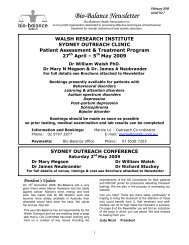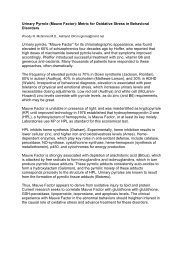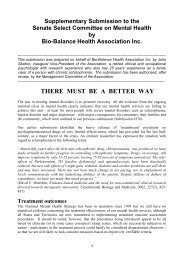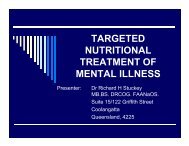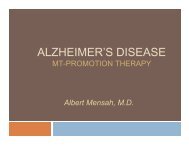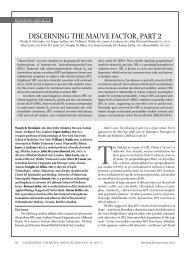Download PDF - Bio-Balance Health
Download PDF - Bio-Balance Health
Download PDF - Bio-Balance Health
- No tags were found...
You also want an ePaper? Increase the reach of your titles
YUMPU automatically turns print PDFs into web optimized ePapers that Google loves.
Can a gut bacteria imbalancereally cause autism?Dr Elisa Hill & Prof. Joel BornsteinEnteric Neuroscience & Autism, University of MelbourneABC’s Four Corners recently aired a controversialdocumentary (The Autism Enigma) on how gut bacteriamight affect autism. Here we review some of the sciencesurrounding what it suggested caused autism – theinvolvement of gut (or enteric) bacteria.The human microbiome includes viruses, fungi andbacteria, their genes and their environmentalinteractions, and is known to influence humanphysiology. To suggest, as The Autism Enigma does, thatthe microbiome is altered in autism and that aprescription of antibiotics to modulate gut bacteria can“cure” autistic characteristics is premature.Our knowledge of the microbiome is in its early stages,and two recent landmark studies show that it is socomplex that scientists can’t yet match gut flora profilesbetween healthy subjects.There’s very broad variation in these bacteria in differentpeople and that severely limits our ability to create a“normal” microflora profile for comparison amonghealthy people and those with any kind of health issue,including autism.How the gut worksLet’s step aside from the puzzles of the microbiome for amoment to consider the basics of how our digestive tractfunctions. It may surprise some to hear it referred to as amini brain, but our gut contains 500 million neurons andcan go about its business independently of the brain, sothe title is apt.These enteric (gut) neurons are arranged in two web-likelayers (plexuses) sandwiched between the two tubes ofmuscle that form the digestive tract. The neurons controlthe gut, contracting the muscle to propel or mix itscontents, as well as triggering secretion of water andenzymes to aid digestion and absorb nutrients.Although it’s too early to suggest that the microbiome iswhere the cause of autism can be found, some of theissues covered in the documentary are solidly supportedby scientific literature. Gut bacteria interact with entericneurons and the mucous membrane of the digestivetract, for instance, and changes in these bacteria canalter anxiety-like behaviours and memory function.Signals produced by the metabolic products of the gutflora can indeed travel to the brain via several differentroutes, including via vagal and spinal sensory nerves, andalter function in the central nervous system. And changesin brain gene expression have been observed in mice fedsome bacterial strains.The role of fatty acidsGut bacteria produce many products (including fattyacids) that affect neuronal function. One of theresearchers interviewed in The Autism Enigma showedthat rats became less social when their brains wereinjected with one particular fatty acid (propionic acid).The documentary suggested that some fatty acids maycause autism; in particular regressive autism, wherechildren forget skills learnt during their early years. Itsuggested that this might happen when fatty acid levelsare altered due to dietary changes when families migrateto a new country and adapt to new foods. The specificexample it provided was of Somali families withtraditionally high-fibre diets that migrate to Canada andadapt to a Western high-sugar diet.The Autism Enigma specifically focused on propionicacid, a short-chain fatty acid product of bacterialfermentation in the gut. This is one of the three shortchainfatty acids (the others are acetic and butyric acids)that are the main fermentation products of bacteria inthe gut. The main fuel for this fermentation process isdietary fibre.Short-chain fatty acids have several roles that promotegastrointestinal health. They are the predominant energysource for the mucous membrane of the colon andimportant for secretion and absorption. And theymaintain an acidic environment in the colon, whichreduces the growth of pathogenic organisms.Blaming sugarGut bacteria are largely confined to the third portion ofthe small intestine, the pouch connected to the junctionof the small and large intestines (caecum) and theadjacent portion of the colon. Sugars, proteins and fatsare digested well before food reaches the colon, and arelargely in the form of fibre by the time they reach thecolon, not carbohydrates as suggested in The AutismEnigma.Increased levels of propionic acid production are likely tobe due to increased dietary fibre, not sugars per se. So,increased propionic acid production would logicallycorrespond with a high-fibre diet, rather than a highsugardiet. This contrasts with the documentary, whichsuggests diets high in carbohydrates and sugars wouldfeed the gut bacteria. In fact, the original diet of Somalifamilies with high levels of autism includes manyfermented foods, which would also be high in propionicacid.There are many theories about the causes of autism, anda role for the microbiome is only one of them.[THE CONVERSATION 6 September 2012]January 2013 18Serial No 15



